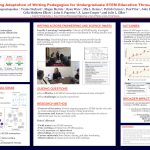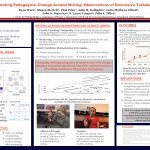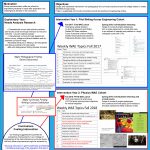Research and Publications
2024
This article reports on a mentoring case from a transdisciplinary, longitudinal writing-across-the-curriculum (WAC) initiative in which the situated complexities of integrating new writing pedagogies were observed and supported. Considering this case through an agential realist lens, we introduce the concept of “discursive turbulence”: an emergent quality of situated semiotic activity produced from the continual mixing of discourses. Discursive turbulence can emerge in myriad and complex ways, including fits-and-starts of pedagogical development, mismatched discursive alignments, affective signs of struggle and intensity, and nonlinear patterns of change. Through a series of four vignettes, we illustrate discursive turbulence as it emerged while pedagogical changes around writing were being implemented by an environmental sciences professor. We suggest that discursive turbulence is to be expected in heterodisciplinary spaces, and we argue that attention to discursive turbulence will lead to more robust accounts of learning, becoming, and literate activity, as well as new ways of supporting pedagogical becoming.
2022
Scholarship animating both WAC/WID (Allan, 2013; Gere, et al., 2018; Hendrickson, 2016; Kells, 2007; Reid, et al., 2016) and STEM (Roth, 2003; Roth & Jornet, 2013; Tsui, 2007) has increasingly called for pedagogical attention to learners’ lived, embodied experiences of knowing, writing, and becoming in and across disciplinary worlds. As one response to such calls, this article argues for “literate activity” (Durst, 2019; Prior, 1998, 2015; Prior & Shipka, 2003) as a productive approach to addressing people’s embodied engagements with semiosis in unfolding moments that are historically dispersed across people, tools, times, and places. To illustrate what attention to literate activity offers for understanding writing and learning, we present analyses of learners’ embodied actions across an array of semiotic resources including texts, talk, images, and gestures for two different STEM settings: physics and organic chemistry. In addition to foregrounding the wealth and variety of semiotic modalities that mediate students’ embodied engagement with disciplinary science, our analyses illuminate the extended histories of semiotic activity that learners continually build as they fashion disciplinary ways of knowing, writing, and becoming.
The ability of engineers and scientists to communicate effectively and persuasively is a critical competency that has been emphasized by the National Academies, yet remains challenging to develop. The long-term objective of this work is to improve the writing skills of undergraduate students pursuing science, technology, engineering, and mathematics (STEM) degrees in a lasting, cost-effective, and scalable way. Guiding Questions: The current focus of this project is to evaluate the effectiveness of a novel program, Writing Across Engineering and Science, at i) improving STEM faculty awareness of best practices from writing studies and ii) encouraging their creative adaptation of those best practices. Writing Across Engineering and Science has been developed through a transdisciplinary action research approach and aims to empower STEM faculty to teach writing more effectively and in alignment with their disciplinary context. The program differs from traditional approaches in being grounded in transdisciplinary co-creation rather than transmission, in incorporating faculty learning communities, and in providing support during the development and implementation of pedagogical changes. Our on-going analysis of the program is based on faculty surveys, interviews, and analysis of course materials.
Our work aims to support engineering and science faculty in adapting core concepts and best practices from writing studies and technical communication for their courses. We also study the effectiveness of varied supports, with an aim of improving the diffusion of effective pedagogies. Our Writing Across Engineering and Science (WAES) program includes a semester-long faculty learning community, followed by sustained mentoring, during which faculty and graduate students from our multidisciplinary team work with mentees to develop and implement new pedagogies and course materials. For graduate students, we developed an engineering course focused on engineering and science writing practices and pedagogies. This paper focuses on one key finding from our analysis: discussions about writing practices involving people from different disciplines often involve irregular and sporadic bumpiness through which foundational changes can emerge. We call this phenomenon discursive turbulence. In our experience, signs of discursive turbulence include affective intensity and co-existing contradictory beliefs. We share four examples to illustrate ways in which discursive turbulence appears, drawn from people with varying degrees and types of engagement with our transdisciplinary work: i) project team members, ii) a faculty mentee, iii) faculty who participated in a focus group on disciplinary writing goals, and iv) engineering graduate students who took our class on writing practice and pedagogy. Discursive turbulence now informs our mentoring approach. It can be generative as well as challenging. Importantly, it takes time to resolve, suggesting the utility of sustained mentoring during pedagogical change.
Development of effective communication skills in engineering students is critical, yet challenging. As engineering programs are technically rigorous, work-intensive, and challenged by their high enrollment numbers, methods to improve students’ writing skills must be costeffective and scalable. This paper describes pedagogical changes and shares course materials designed to integrate core concepts from writing studies into an advanced laboratory-based civil engineering course. We incorporate language units developed by the Civil Engineering Writing Project that provide strong connections to professional engineers’ writing. Specific concepts that guided the redesign are genre awareness and flexibility, process orientation to writing, and global, prioritized feedback. Several semesters into the iterative implementation of these changes, teaching assistants observe greater student engagement, without an increase in teaching workload.
2020
Although professional boards and engineering employers have emphasized written communication as a key feature of engineering education and practice, a range of challenges—from lack of pedagogical training in writing to large class sizes and heavy content requirements—often prevent science, technology, engineering, and math (STEM) faculty from incorporating writing instruction into classes. This paper focuses on a key theoretical concept from the field of writing studies, writing-as-process, and explores how it has been included by STEM faculty in their teaching. We first review theoretical and empirical work that supports writing-as-process as an effective tool for facilitating student learning. We then illustrate how writing-as-process has been incorporated into varied types of courses, drawing on a multi-year intervention project designed to enhance writing in engineering and STEM. The examples describe reflective, writing-to-learn activities for first-year orientation courses; scaffolded approaches for laboratory and problem-based-learning classes; and directed peer review and response to reviewer comments in middle- and upper-level courses. The paper concludes by addressing the challenges to adopting writing-as-process in STEM, including issues of scale and faculty development.
Providing contextualized, effective writing instruction for engineering students is an important and challenging objective. This article presents a needs analysis conducted in a large engineering college and introduces the faculty development program that was created based on that analysis. The authors advocate for sustained interdisciplinary collaboration to promote contextualized adoption and adaptation of best practices and testing of scalable strategies.
2019
As the Accreditation Board for Engineering and Technology (ABET) has emphasized, engineering students must develop effective communication skills for successful transition to the workplace after graduation. Embedding communication instruction in technical courses signals to students that their profession values communication, facilitates transmission of discipline specific conventions, and tackles difficulties associated with learning transfer. However, STEM faculty seldom receive any preparation to teach writing or other types of communication. Situated in the College of Engineering at the University of Illinois at Urbana-Champaign, we have undertaken a multi-year collaboration between STEM and Writing Studies faculty and graduate students that aims to improve engineering students’ writing and communication. Taking a transdisciplinary action research approach, we follow an integrative, iterative model of intervention and assessment. This paper describes a program titled “Writing Across Engineering” (WAE). WAE was designed to support STEM faculty as they work to integrate writing and writing instruction in their classes and curricula. We see our paper as a theoretical-methodological framework for others interested in designing collaborative professional development for writing instruction at their own universities.
STEM instructors are often not well prepared to assist students in developing as writers or to respond to student writing effectively. Recognizing this challenge, STEM and Writing Studies faculty and graduate students created a long-term collaboration, Writing Across Engineering (WAE), in the College of Engineering at the University of Illinois at Urbana-Champaign. By participation in WAE, the instructional staff of a writing-intensive physics course engaged in a year-long effort to explore and apply evidence-based best practices for writing instruction. In this paper, we focus on how changes in the rubrics for responding to/grading student writing became central to redesigning instruction. A key disconnect was identified between the learning goals for writing, implicit in the course materials and thus not communicated to students, and the details of instructional practice. Changes to the grading rubrics, as well as assignments, addressed this disconnect by shifting response practices away from being heavily focused on strict adherence to specific text conventions. Rather, response became more comprehensive, incorporating best practices from Writing Studies, such as building genre awareness, teaching writing as a process, and using prioritized, selective feedback. The new rubrics also better aligned with the original learning goals and enabled those goals to be both communicated to students and explicitly expressed in the course. We conclude with a discussion of lessons learned and the potential for uptake in other courses and institutions.
2018
Recognizing challenges to developing undergraduate engineering students’ writing, the University of Illinois at Urbana-Champaign College of Engineering invited instructional innovation proposals to tackle this issue. Bringing together faculty and graduate students from engineering and writing studies, our team proposed first researching current undergraduate writing instruction in engineering at our large research university. We applied a mixed-methods approach, including administering surveys, conducting discourse-based interviews, collecting course documents, and analyzing curricular pathways. Our team also examined best practices found in writing studies research. We found that current writing assignments are rarely well aligned with professional genres, that current writing instruction often does not employ best practices from the writing studies literature, and that departmental curricula do not distribute writing across the four-year programs. Our findings suggest the potential for substantive writing instruction improvements in our College of Engineering. In this paper, we document our findings and propose a path to improving writing instruction for undergraduate engineering students, beginning with educating our engineering faculty about best practices and helping them implement those practices in their classes.




